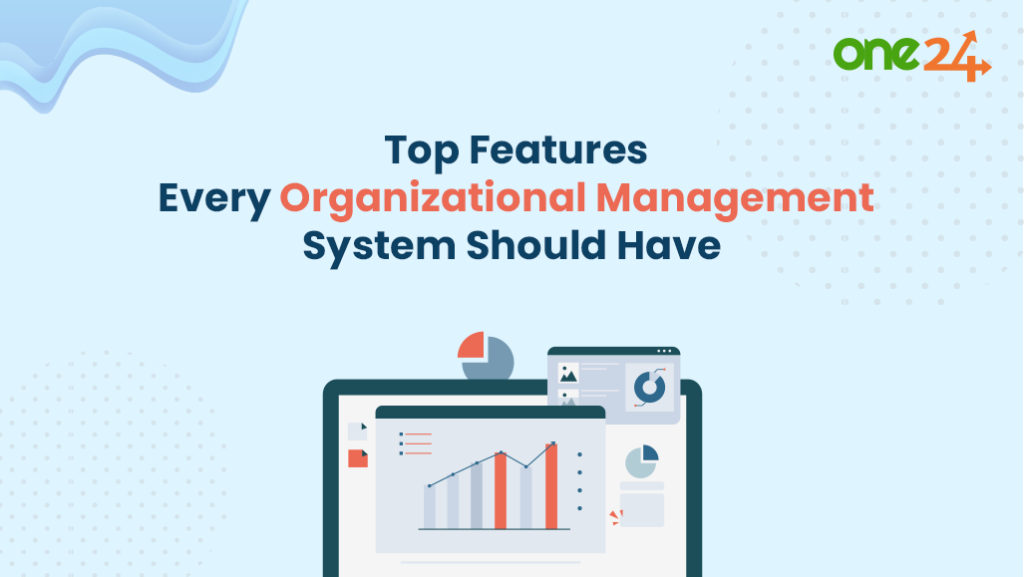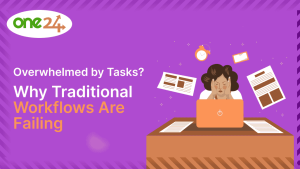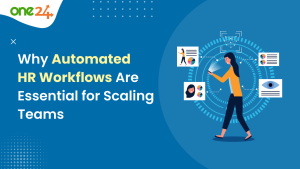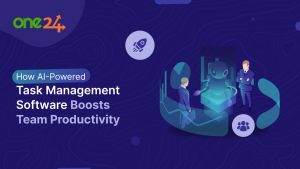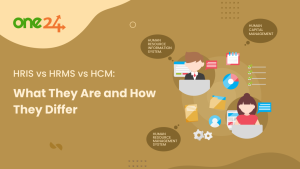Imagine Sarah doing a plethora of chores each day as the HR manager of a quickly expanding software company. Her to-do list never seems to end, ranging from managing employee performance and onboarding new workers to making sure complex labor rules are followed. Even with her best efforts, her staff frequently misses deadlines, pays attention to details, and becomes increasingly frustrated due to the manual processes and inconsistent systems she depends on.
While sorting through piles of papers and switching between different software programs one very busy morning, Sarah came upon a solution that looked like it would completely change her workflow: One24, an Organizational Management System (OMS). She was intrigued, so she dug deeper and found a world where all her HR responsibilities could be automated and merged smoothly, releasing her from manual management.
Sarah’s tale is not the only one. Several HR specialists and company executives struggle to meet the demands of a fast-paced work environment. These difficulties may be turned into opportunities with the correct OMS, which will streamline processes and promote a more productive and engaged team.
We’ll set out on a quest to identify the essential components that any Organizational Management System ought to possess in this article. These capabilities will assist you in confidently and easily navigating the challenges of contemporary business, from streamlining daily chores to offering strategic insights. Come learn how an effective OMS may transform your daily organizational management tasks into a smooth and productive process.

- Human Resources
Through many crucial components, the Human Resources feature of an Organizational Management System (OMS) simplifies operations.
- Interview Management: A smooth hiring process is ensured by Interview Management, which automates scheduling, integrates calendars, offers uniform templates, and makes it easier to collect feedback in real time.
- Leave Management: Ensures openness and adherence to corporate standards by enabling employees to request leaves online, tracking leave balances, automating approval operations, and producing data on leave trends.
- Attendance management: Tracks attendance, detects absenteeism trends, and connects with payroll for precise timekeeping and compliance. It also provides clock-in/clock-out capabilities via mobile apps or biometric systems.
- Ticketing and Support Management: Uses a comprehensive knowledge base, an automated ticketing system for frequently asked questions, and categories to manage HR-related concerns. It keeps track of ticket response times and assigns problems to the right people.
- Candidate Management: Automates screening, keeps track of applicants from application to hiring, expedites communication and interview scheduling, and keeps a database of profiles.
- Onboarding Process Management: To provide seamless integration for new hires, Onboarding Process Management digitizes onboarding using e-forms and automated workflows, assigns responsibilities, monitors progress, and grants access to training modules and resources.
- Relieving Procedures: Facilitate an effective offboarding process by automating exit interviews, tracking and recovering assets, rescinding system access, managing documentation, and ensuring compliance with legal and corporate standards.
- Project Management
The Project Management feature within an Organizational Management System (OMS) empowers teams to efficiently plan, execute, and monitor projects from inception to completion.
- Portfolio Management: Enables organizations to oversee multiple projects simultaneously, ensuring alignment with strategic objectives and optimal resource allocation.
- Client Management: Facilitates seamless communication and collaboration with clients, providing a centralized platform for correspondence, document sharing, and feedback collection.
- Task Management: Streamlines project workflows by assigning tasks, setting deadlines, and tracking progress in real-time, promoting accountability and transparency among team members.
- Time Management: Allows employees to log and track their time spent on project-related activities, aiding in accurate billing and resource planning.
- Payment and Invoice Management: Automates invoicing processes, tracks payments, and generates financial reports, ensuring timely payments and financial transparency throughout the project lifecycle.
- Hardware & Assets
The Hardware & Assets feature within an Organizational Management System (OMS) streamlines the management of hardware and assets across the organization, ensuring efficient utilization and maintenance.
- Inventory Management: Provides a centralized database of all hardware and assets, allowing organizations to track quantities, locations, and statuses in real time.
- Hardware Allocation: Facilitates the allocation of hardware to employees or departments based on need, ensuring equitable distribution and optimal utilization.
- Adding or Removing Assets: Allows organizations to add new assets to the inventory or remove outdated assets, maintaining an accurate and up-to-date inventory.
- Device Management: Enables organizations to monitor and manage devices remotely, ensuring security compliance, software updates, and troubleshooting as needed.
- Departments & Teams
The Departments & Teams feature in an OMS enhances collaboration and efficiency within the organization by providing tools for effective departmental and team management.
- Task Assignment: Allows managers to delegate tasks to team members, track progress, and ensure timely completion, fostering accountability and productivity.
- Appraisal Management: Facilitates performance evaluations by providing a structured framework for setting goals, tracking achievements, and conducting reviews, promoting employee development and recognition.
- Efficiency Tracking: This enables organizations to monitor team and departmental efficiency metrics, identify areas for improvement, and implement strategies to optimize performance.
- Employee Reviews: Provides a platform for conducting performance reviews, gathering feedback, and documenting performance history, supporting fair and transparent evaluation processes.
- Reports Management: Allows organizations to generate and analyze reports on departmental and team performance, providing valuable insights for decision-making and strategic planning.
- Employee Management
The Employee Management feature in an Organizational Management System (OMS) serves as an extensive platform for overseeing various aspects of employee administration and engagement.
- Timesheet: This functionality allows employees to log their working hours, facilitating accurate payroll processing and project tracking.
- Leaves and Holiday Calendar: Enables employees to request and manage their leaves, while also providing visibility into company-wide holiday schedules.
- My Assets: The feature allows employees to view and manage company-provided assets assigned to them, such as laptops or mobile devices.
- My Attendance: Functionality provides employees with access to their attendance records, including clock-in/clock-out times and leave balances.
- Profile Management: Allows employees to update their personal information, contact details, and emergency contacts, ensuring data accuracy and compliance.
- Employee Monitoring System: Offers tools for tracking employee productivity, performance, and engagement, providing insights for management and HR decision-making.
- Sales Management
The Sales Management feature within an Organizational Management System (OMS) streamlines sales processes and optimizes revenue generation through various key components.
- Lead Management: Facilitates the organization and tracking of potential sales opportunities, allowing sales teams to efficiently nurture leads through the sales funnel.
- Sales Collaboration: Promotes teamwork and information sharing among sales representatives, enabling them to collaborate on deals, share insights, and coordinate efforts to maximize sales effectiveness.
- Lead Pipeline: Provides a visual representation of the sales process, allowing sales teams to monitor the progress of leads through each stage of the pipeline and identify bottlenecks or areas for improvement.
- Lead Analytics and Reporting: Offers comprehensive analytics and reporting tools to track key performance metrics, measure sales effectiveness, and identify trends or patterns in lead conversion and sales performance.
Ending The Tale
For companies of all sizes, the appropriate Organizational Management System (OMS) may be a game-changer, as demonstrated by Sarah’s journey. An OMS streamlines the intricate web of HR duties and procedures by incorporating necessary features like thorough onboarding and offboarding, ongoing performance management, precise time and attendance monitoring, and strong payroll connection.
The finest OMS solutions provide strong tools for learning and development, compliance management, employee self-service, and data-driven analytics in addition to these fundamental components. These functions encourage employee empowerment, engagement, and strategic decision-making in addition to streamlining operations.
In a world where agility and efficiency are critical, an OMS is not an option; it is a must. It turns the difficult, time-consuming task of organizational management into a smooth, effective, and incredibly fruitful undertaking. By selecting an OMS with the appropriate capabilities, you may raise the bar for operational excellence, improve worker happiness, and eventually steer your company in the direction of long-term success.
Invest in a strong Organizational Management System today, and see how it transforms your HR procedures, gives your employees more power, and fosters the expansion of your company. Effective, engaging, and efficient organizational management is the way of the future, and it begins today.
People Also Ask
1. What is an Organizational Management System?
It is a software program made to automate and simplify many parts of organizational administration, such as asset management, project management, and human resources.
2. Why is having an OMS with the best features important?
Organizations can efficiently manage their operations, increase productivity, and accomplish strategic goals with an OMS that has the best features. These functions facilitate communication, increase efficiency, and offer insightful data for making decisions.
3. What essential components must be present in every OMS?
HR functions including leave management, interview management, and onboarding process management, together with project management tools like work assignment and time management, are some of the important aspects.
4. How might my company profit from an OMS?
Your company can gain from an OMS by increasing employee happiness, fostering improved cooperation and communication, increasing operational efficiency, and boosting overall business success.
5. How can I pick the ideal OMS for my company?
Take your organization’s unique goals, financial constraints, and scalability requirements into account when selecting an OMS. Seek a solution with the features you require, seamless integration with your current systems, and top-notch customer service.
6. Is it possible to modify an OMS to meet the particular needs of my company?
Numerous OMS solutions provide customization choices so you can fit the system to the unique requirements of your company. Seek a solution that offers adjustable workflows and adaptable configurations.
7. How can I make sure an OMS is successfully adopted and implemented?
An OMS cannot be successfully implemented or adopted without efficient change management, user education, and continuing assistance. To guarantee employee buy-in, involve stakeholders early in the process, offer thorough training, and highlight the advantages of the new system.
8. What level of assistance can I anticipate from OMS providers?
OMS suppliers often give a variety of support services, including continuing technical support, training materials, and help with implementation. Choose a supplier that provides timely system updates and attentive customer service.
9. How can the ROI of putting in place an OMS be calculated?
The return on investment (ROI) from deploying an OMS may be evaluated by monitoring important indicators including increased output, reduced expenses, higher employee satisfaction, and enhanced operational effectiveness. To determine how the system is affecting the bottom line of your company, conduct frequent evaluations.
10. Where can I find out more about an OMS’s key features and how my company may use them?
Get in touch with One24 to find out more about the best features of an OMS and how they may help your company. Our professionals can offer you individualized advice and assist you in locating the best option for your requirements.

